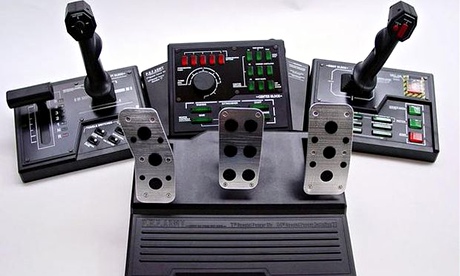
1 Steel Battalion – the cockpit controller
Capcom's Steel Battalion asked players to climb into the virtual cockpit of a towering military robot; the giant "mechas" so popular in Japanese science fiction. But it didn't stop at the virtual, for the game came with a huge controller, about 85cm wide. It had about 40 buttons, joysticks, switches, levers, thumbsticks, dials and – on a separate module placed on the floor – foot pedals. The game, which saw its mecha stars exchange fire on a battlefield, was in equal measures punishing and finicky. A battle started with a complex boot-up routine with much switch-flicking in the hanger, as if bringing to life an eccentric workshop contraption for the first time. Players were then expected to consider windscreen wiping and such during battle and, should they lose control and see their robot tumble to the floor, the game's entire save file was erased unless a finger could find the covered ejector seat button in time. While the controller worked only with Steel Battalion and its first sequel, the third game in the series went to the other extreme; it was played using just the hands, in front of Kinect. Forty buttons, it turned out, really did need to be there to make it feel remotely exciting.
2 Rez – The Trance Vibrator
Rez remains the defining release of the synaesthesia genre, which presents games that try to fuse audio, visual and interactive experiences into a single entity. Developer Tetsuya Mizuguchi furnished Dreamcast and PlayStation 2 with Rez with much pounding bass, which served as a backbone for the rest of the abstract sci-fi shooter. Action would often feel as if were dictated by bass lines, while the visuals pulsed to the same beat. In recognition of which, publisher Sega released the special package version of Rez. If you picked up a hint of innuendo in the name, you weren't alone. When it turned out the special package contained a large vibrating block that throbbed to Rez's bass lines, to be held against the body while playing, the floodgates opened, and ever since the device has been haunted by jokes about its role as an improvised sex toy.
3 Konami – The LaserScope
The concept of the LaserScope no doubt thrilled children in 1990. A head-mounted lightgun conceived to fire through voice control, it felt enticingly futuristic. Aesthetically, it was a peculiar apparatus; an ungainly hybrid of Alice band, Madonna mic and a starship fighterpilot's helmet, ultimately resulting in a gadget that suggested a telephonist trapped in a nightmare vision of the future as imagined by someone obsessed with 1980s pop culture. It had two significant flaws: playing during a game's more intense moments presented a definite threat to the user's neck, but it was the voice activation that attracted the most cutting criticism on release. Saying "fire" was supposed to unleash a shot, but it didn't always work. Equally you could also say anything else, breathe too heavily or be unlucky with background noise and the LaserScope would also – or depending on its mood, wouldn't – fire a shot.
4 Densha de Go – various train controllers
The Densha de Go series sprung to life in Japan's arcades in 1996, spawning numerous console ports and sequels of the train simulation game. Many came with a dedicated controller, with a collections of levers and buttons for what is an unlikely subject to attract a specialist gaming peripheral: guiding a vehicle along rails that already dictate its route. And, in an act of charmingly ludicrous design, some Densha de Go controllers feature their own dead-man's handles. In the real world the dead-man's handle serves a crucial purpose, here, in a simulation, it is a wonderful anomaly – part of the peripheral that only actually achieves its function when interaction with it ceases. A glorious idea, with a philosophical whiff of quantum theory to it – a "button" that only does its job when not pushed … Not that it seemed to bother the legions of wannabe train drivers, who lapped it up.
5 ASCII – Gamecube keyboard controller
The Gamecube online action-RPG Phantasy Star Online Episode I and II let users communicate while playing by using a keyboard. Keyboard support for the console, however, was rather limited and swapping back and forth between gamepad and text entry was far from ideal. Recognising this, ASCII came up with what sounds like a simple idea; they combined a keyboard and gamepad in a single controller. It stretched out a standard pad's common form, dropping keys into the newly formed gap between the thumbsticks and buttons. The problem was that, while ultimately functional, a gamepad the width of keyboard place sit at the very fringe of ergonomic design. And, of course, to use the keys to type you still had to put the Frankenstein-monster of a contraption down. Just like swapping between two controllers, then.
6 Resident Evil 4 – The Chainsaw
Resident Evil 4 gave the popular horror series a subtle new move into the territory of traditional third-person shooters. As such, gunplay was the game's most significant combat mechanism. Yet both the Gamecube and PlayStation 2 releases of the well-received title saw their own official chainsaw-shaped controllers made available as an option for the most dedicated Resident Evil fans. And so it was that they could shoot enemies in the game using a plastic, power tool-shaped pad designed in a way that did little to recognise the reality of the shape of human hands. But while uncomfortable, thematically confused and grotesque in realisation, the blood-splattered chainsaw controller boasts an outlandish allure few other gaming peripherals can inspire in collectors.

